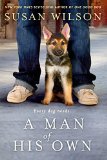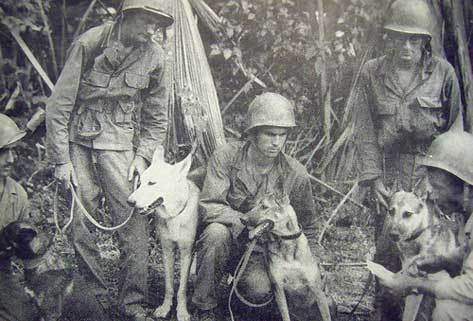Summary | Excerpt | Reviews | Beyond the Book | Read-Alikes | Genres & Themes | Author Bio

Critics' Opinion:
Readers' Opinion:
First Published:
Sep 2013, 320 pages
Paperback:
Jan 2015, 368 pages
 Book Reviewed by:
Book Reviewed by:
BookBrowse First Impression Reviewers
Buy This Book
This article relates to A Man of His Own
On December 7, 1941, Pearl Harbor was attacked and the US entered the war. The value of dogs in the military had been proven many times, particularly during WWI, as they were used by the European armies as sentries, message-carriers and fox-hole clearers (of rats before the soldiers entered.). Although there were relatively few military dogs in the US at the time, the need for them was clear.
 A private citizen came to the rescue. Mrs. Alene Erlanger, a well-known, highly respected poodle breeder based in New York, created the Dogs for Defense program. The American Kennel Club supported her idea. For the most part, the public reaction was positive and people were eager to send their dogs to be a part of the war effort. Even Hollywood got involved in the Dogs for Defense program. Greer Garson sent Cliquot, her poodle; Mary Pickford sent Silver, her German shepherd; and Rudy Vallee sent King, his Doberman. It is estimated that 40,000 dogs were sent over a two-year period, and about 10, 000 of these were accepted for full training.
A private citizen came to the rescue. Mrs. Alene Erlanger, a well-known, highly respected poodle breeder based in New York, created the Dogs for Defense program. The American Kennel Club supported her idea. For the most part, the public reaction was positive and people were eager to send their dogs to be a part of the war effort. Even Hollywood got involved in the Dogs for Defense program. Greer Garson sent Cliquot, her poodle; Mary Pickford sent Silver, her German shepherd; and Rudy Vallee sent King, his Doberman. It is estimated that 40,000 dogs were sent over a two-year period, and about 10, 000 of these were accepted for full training.
Initially about 30 different breeds were allowed into the program. Dogs had to be between the ages of 1 and 5 years and weigh at least 50 pounds. Color was a consideration too. More easily camouflaged colors – greys, blacks and browns – were required and dogs with white markings were rejected because they would be too easily spotted. Through trial and error it became clear that the best age to train a dog was around 18 months old, and the most trainable breeds were German Shepherds (excellent nose, strength and courage), Belgian Sheepdogs (exceptionally alert, intelligent and loyal), Collies (alert, fast and able to endure), Siberian Huskies and Malamutes (feet well adapted for ice), and Doberman Pinschers (like the German Shepherds, powerful nose, speed, power and agility).
 Henry Stoecker, a trainer at Alene Erlanger's kennel and Elliot Humphrey, a well-known trainer for the Seeing Eye organization, helped develop the training program. In June 1942, the U.S. Military took control of the training program at the Remount Branch, Service Installations Division, which had previously obtained horses and mules for military service. A few other training camps were set up for specific training purposes. Camp Rimini, which was just outside Helena, Montana, had enough snow throughout the year to train sledge dogs, and Cat Island (barrier island off the Gulf Coast) in Gulfport, Mississippi had a tropical climate which made it ideal for training dogs for the Pacific battles.
Henry Stoecker, a trainer at Alene Erlanger's kennel and Elliot Humphrey, a well-known trainer for the Seeing Eye organization, helped develop the training program. In June 1942, the U.S. Military took control of the training program at the Remount Branch, Service Installations Division, which had previously obtained horses and mules for military service. A few other training camps were set up for specific training purposes. Camp Rimini, which was just outside Helena, Montana, had enough snow throughout the year to train sledge dogs, and Cat Island (barrier island off the Gulf Coast) in Gulfport, Mississippi had a tropical climate which made it ideal for training dogs for the Pacific battles.
The dogs were trained in eight categories:

Many dogs contributed their learned and intuitive skills to the war effort. Two of these canine military partners:
Buster was a messenger dog with Company F, 155th Infantry Regiment on Morotai Island. He ran through heavy machine gun and mortar fire on two different occasions, delivering instructions for the soldiers to hold position because help was on its way. Buster saved the lives of 17 soldiers - an entire patrol. Chips was a sentry dog with General Patton's Africa campaign, as well as with the 3rd Division of Patton's Seventh Army in Sicily. Chips was the first dog to receive the Silver Star and the Purple Heart, (which were ultimately rescinded because the military determined that medals are meant for humans only).
Most of the dogs who survived the war came back home to live with either their original owners or retired with their human soldier partner. In Susan Wilson's A Man of His Own, Pax ends up living with both.
First image: Logo of the Dogs for Defense organization.
Second image: From Community-2 Web TV. Proud Pups! Their moms are war dogs!
Third image: From 26thscoutdog.com. War dogs shown with T5 Paul Biancucci of Hartford, Conn, T5 Edwin Smith of Cross Plains, Ind., T5 George Bertram of Ceder Ridge, Colo, T5 Milton Leavitt of Newburyport, Mass, and T5 Robert K. Robertson of Los Angeles, CA. Near Luzon in January '45.
Filed under Cultural Curiosities
![]() This "beyond the book article" relates to A Man of His Own. It originally ran in October 2013 and has been updated for the
January 2015 paperback edition.
Go to magazine.
This "beyond the book article" relates to A Man of His Own. It originally ran in October 2013 and has been updated for the
January 2015 paperback edition.
Go to magazine.





The Flower Sisters
by Michelle Collins Anderson
From the new Fannie Flagg of the Ozarks, a richly-woven story of family, forgiveness, and reinvention.

The House on Biscayne Bay
by Chanel Cleeton
As death stalks a gothic mansion in Miami, the lives of two women intertwine as the past and present collide.

The Funeral Cryer by Wenyan Lu
Debut novelist Wenyan Lu brings us this witty yet profound story about one woman's midlife reawakening in contemporary rural China.
Your guide toexceptional books
BookBrowse seeks out and recommends the best in contemporary fiction and nonfiction—books that not only engage and entertain but also deepen our understanding of ourselves and the world around us.